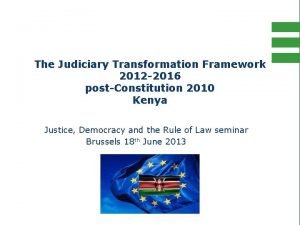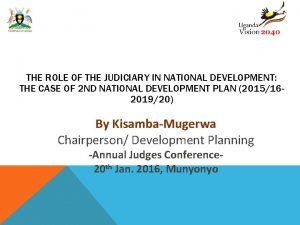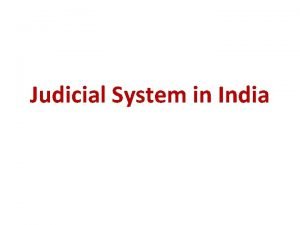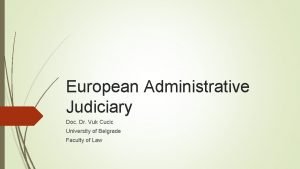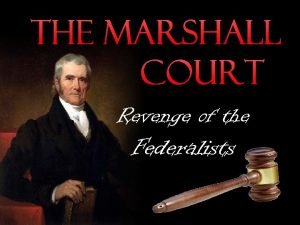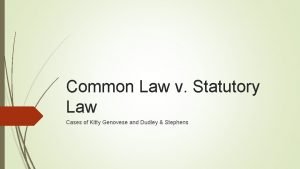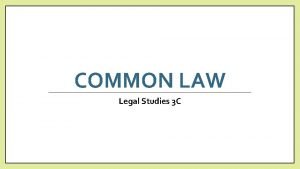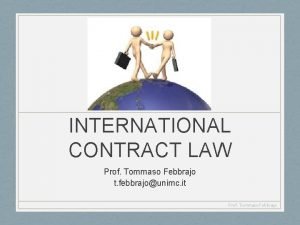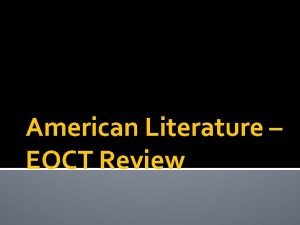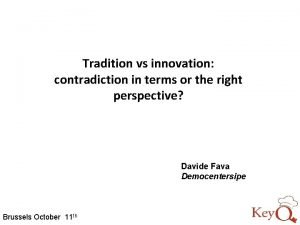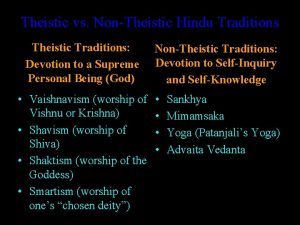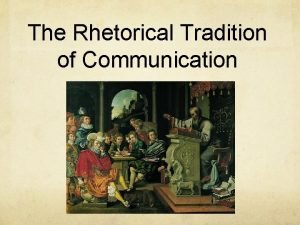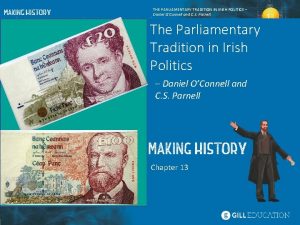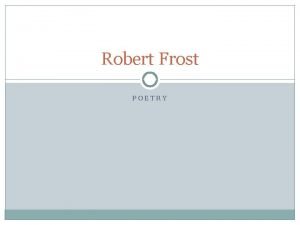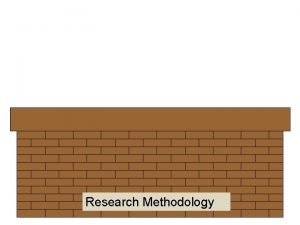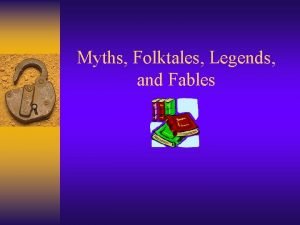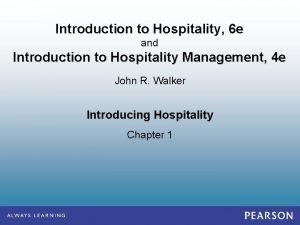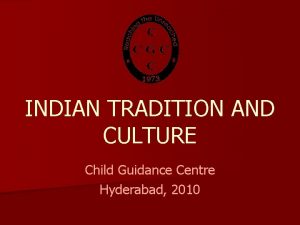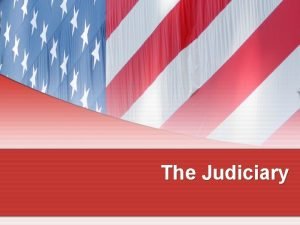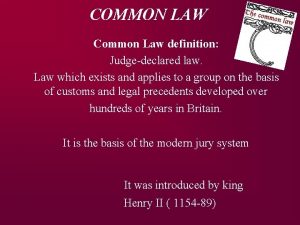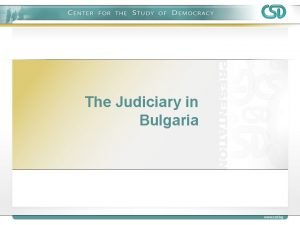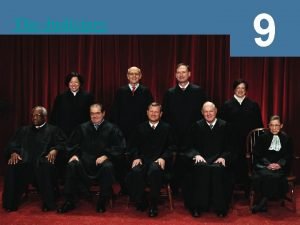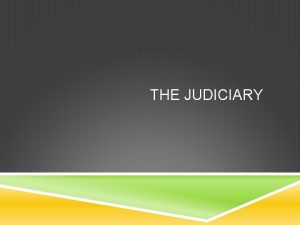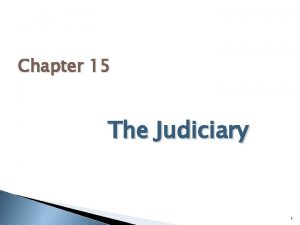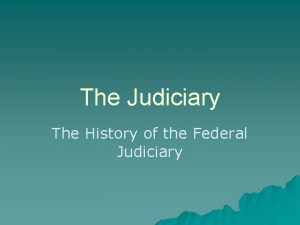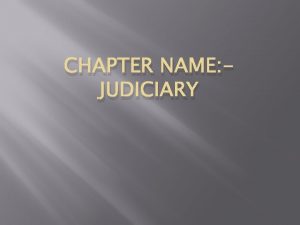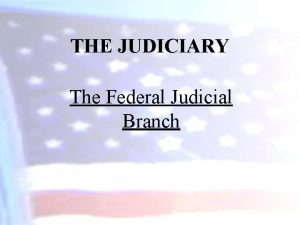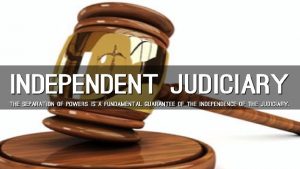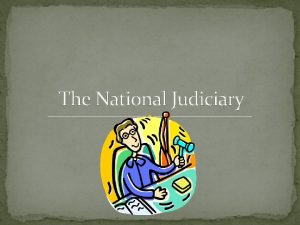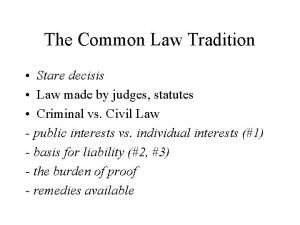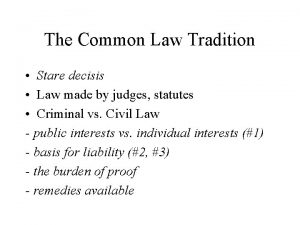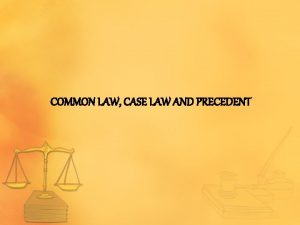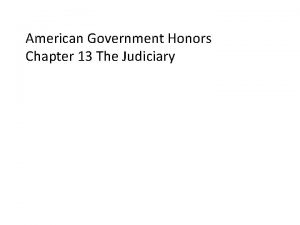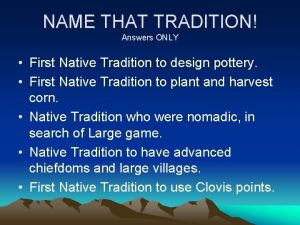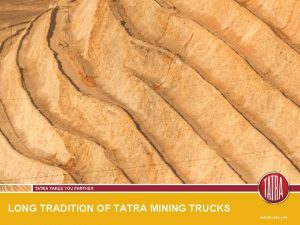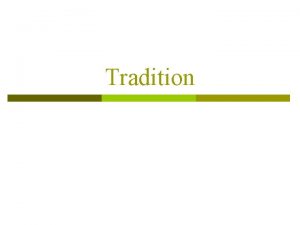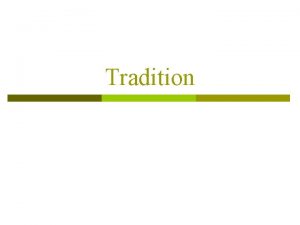The Judiciary The Common Law Tradition American law


































- Slides: 34

The Judiciary

The Common Law Tradition • American law stems from the English legal tradition of common law • Common law • Judge-made law based initially on the prevailing custom and eventually on legal precedent • Common law is based on stare decisis, which means to stand on decided cases Copyright © 2011 Cengage Learning 2

Adversarial Process • Disputes resolved by adversarial process • Each side represented by attorney • Present own version of events • Resolve as fairly as possible • Questions of fact and of law examined • Mistakes may be examined by appeal Copyright © 2011 Cengage Learning 3

The Supreme Court Click on a picture to find out more information about that period in the Court’s history Copyright © 2011 Cengage Learning 4

Development of the Court’s Role in Government • Marbury v. Madison • Judicial Review • Mc. Culloch v. Maryland • National Supremacy A portrait of William Marbury Supreme Court Historical Society Click to return to the timeline Copyright © 2011 Cengage Learning 5

Development of Supreme Court • 18 th Century • Seen as somewhat weak third branch of government • 19 th Century • Marshall Court (1805 -1835) established supremacy of courts to determine law over legislation • Began to limit authority of state courts (supremacy clause, commerce clause) • 1830 s-1930 s began to limit national power over slavery, civil rights and the economy Copyright © 2011 Cengage Learning 6

Development of Supreme Court (cont) • Civil War to 1930 s • Limited scope of civil rights • Separate but equal doctrine • Court supports industrialization and business • Promotes laissez faire economy • Leaves regulation to states Copyright © 2011 Cengage Learning The Supreme Court set national standards for child labor. Utah State Historical Society 7

Development of Supreme Court (cont) • 1930 s • Court tries to block much of the New deal legislation • FDR Court packing plan applies pressure • Court begins allowing greater federal and state regulation • Also begins strengthening national power over civil rights legislation Copyright © 2011 Cengage Learning 8

Modern Supreme Court • Post New Deal Courts have been active in overturning state and federal laws and practices in areas outside economics, including: • • • Civil rights Abortion Prayer Rights of criminal defendants Death penalty Libel and free speech Copyright © 2011 Cengage Learning Supreme Court Justice Elena Kagan 9

The Warren Court (1953– 1969) • Outlawed official racial segregation in public schools • Set strict national standards to protect rights of criminal defendants • Required equal apportionment of state legislatures and the House of Representatives • Ruled prayers and Bible reading in public schools were unconstitutional • Created right to privacy Click to return to the timeline Copyright © 2011 Cengage Learning 10

The Burger Court (1969– 1986) • Narrowed reach of the Fourth Amendment’s protections against unreasonable search and seizure • Restored death penalty • Most decisions shifted toward the conservative, yet, many decisions still protected individual liberties and minority groups • Roe v. Wade Click to return to the timeline Copyright © 2011 Cengage Learning 11

The Rehnquist Court (1986– 2005) • By 1988, the Court shifted in conservative direction • Often favored state’s rights • The Court also made it more difficult for workers to sue employers for discrimination • Ended 2000 presidential election dispute • Decisions were often hard to categorize, and the conservative did not always prevail Click to return to the timeline Copyright © 2011 Cengage Learning 12

The Roberts Court (2005 -? ) Click to return to the timeline Copyright © 2011 Cengage Learning 13

Sources of American Law • Constitutions • U. S. Constitution is supreme law of land • Statutes and Administrative Regulations • Case Law Copyright © 2011 Cengage Learning 14

The Federal Court System • Basic Judicial Requirements • Jurisdiction: The authority to hear a case • Original: The place where the case is heard first • Appellate: Hearing a case on appeal or for a second time • Federal Jurisdiction • Subject matter: admiralty or maritime law • Parties involved • Supreme Court has both Original and Appellate Jurisdiction • Anything that does not fall under Federal Jurisdiction 15 the states can hear Copyright © 2011 Cengage Learning

The Federal Court System Copyright © 2011 Cengage Learning 16

Types of Federal Courts • • U. S. District Courts U. S. Courts of Appeals The United States Supreme Court Specialized Federal Courts • • FISC (Foreign Intelligence Surveillance Court) Alien “Removal Courts” Court of International Trade Tax Court Copyright © 2011 Cengage Learning 17

Geographic Boundaries of Federal District Courts and Circuit Courts of Appeals Copyright © 2011 Cengage Learning 18

Parties and Procedures • Plaintiff • Defendant • Litigate © Paul Conklin /Photo. Edit Copyright © 2011 Cengage Learning 19

Parties and Procedures (cont) • Amicus Curiae (friend of the court) brief • Filed by third party with an interest in the outcome • Procedural Rules • Civil contempt: failure to comply with court’s order • Criminal contempt: obstructing administration of justice Copyright © 2011 Cengage Learning 20

Legal Terms • Civil case: disputes about something of value • Criminal case: violation of law • Plea bargain: negotiating severity and number of charges to be brought against defendant • Adjudication: court judgment resolving the claims and enforcing the decision Copyright © 2011 Cengage Learning 21

Which Cases Reach the Supreme Court? • When two lower courts are in disagreement • When a lower court’s ruling conflicts with an existing Supreme Court ruling • When a case has broad significance • Desegregation, abortion • When a state court has decided a substantial federal question Copyright © 2011 Cengage Learning 22

Which Cases Reach the Supreme Court? (cont) • When the highest state court holds a federal law invalid, or upholds a state law that has been challenged as violating a federal law • When a federal court holds an act of Congress unconstitutional • When the Solicitor General is pressuring the Court to hear a case Copyright © 2011 Cengage Learning 23

Cases Before the Court • Granting Petitions for Review is granted by a writ of certiorari • To issue a writ, a minimum of four justices must agree that the case should be heard by the Supreme Court (the “rule of four”). • The Court generally agrees to hear about 1% of the petitions brought before it Copyright © 2011 Cengage Learning 24

Deciding Cases • Once the Court has decided to accept a case, both parties in the case will submit legal briefs and (usually) make oral arguments. • If the Court is unanimous in the ruling, one justice will write the opinion of the Court • If the justices are divided on the reasoning of the outcome, there will be a majority opinion and dissenting opinions Copyright © 2011 Cengage Learning 25

The Selection of Federal Judges • Judicial Appointments • Federal District Court Judgeship Nominations • Federal Courts of Appeals Appointments • Supreme Court Appointments • Partisanship and Judicial Appointments • Senatorial Courtesy • Allows senators to recommend/veto candidates for judgeships in state Copyright © 2011 Cengage Learning 26

Senate Confirms Sotomayor The Senate confirms the first Hispanic judge to be nominated to the Supreme Court. Airdate: 8/6/2009 Click the icon to open the movie Video Supplied by Motion Gallery Copyright © 2011 Cengage Learning 27

Policymaking and the Courts • Judicial Review • Power of the courts to determine whether a law or action is constitutional • Judicial Activism • Going beyond law to impose policy interpretations • Judicial Restraint • Strictly honoring letter decisions of other courts • Strict Construction (letter of the law) • Broad Construction (intent of the law) Copyright © 2011 Cengage Learning 28

Ideology and the Courts • The ideology of the justices determines the kinds of policy that the courts will make • Activist • Restraintist Lynn Johnson/Aurora Photos Copyright © 2011 Cengage Learning 29

What Checks Our Courts? • Executive Checks • Legislative Checks • Constitutional amendments • Revision of laws • Public Opinion • Current Events Copyright © 2011 Cengage Learning 30

Judicial Traditions and Doctrines • To a certain extent, the courts also check themselves • The Impact of the Lower Courts • Stare Decisis: doctrine which obligates all courts to rely on established precedents Copyright © 2011 Cengage Learning 31

The War in the Courthouse The story profiles evangelical Christians concerned about judicial appointments. Airdate: 5/19/2005 Click the icon to open the movie Video Supplied by Motion Gallery Copyright © 2011 Cengage Learning 32

Criminal Rights • Constitutional rights • • Unreasonable search and seizure Due process Speedy and public trial Against self-incrimination Double jeopardy Right to legal representation Forbids cruel and unusual punishment Copyright © 2011 Cengage Learning 33

Criminal Rights (cont) • Supreme Court defines and interprets rights • May change in response to public opinion (death penalty) • Defines some criminal rights • Miranda v. Arizona • Gideon v. Wainwright Copyright © 2011 Cengage Learning 34
 Judicial transformation framework
Judicial transformation framework Judicial activism cases
Judicial activism cases Cohesive society and preserved identity
Cohesive society and preserved identity Department of judiciary
Department of judiciary Judiciary system in india
Judiciary system in india Judiciary
Judiciary Whats the judiciary act
Whats the judiciary act Difference between statute and common law
Difference between statute and common law Doctrine of precedent
Doctrine of precedent Common law and civil law
Common law and civil law Examples of civil law
Examples of civil law Tommaso febbrajo
Tommaso febbrajo Lcm of 48 and 60
Lcm of 48 and 60 Common anode and common cathode
Common anode and common cathode Factor tree of 48
Factor tree of 48 What are the factors for 54
What are the factors for 54 Greatest common factor and least common multiple
Greatest common factor and least common multiple Highest common factors and lowest common multiples
Highest common factors and lowest common multiples Themes of american literature
Themes of american literature Newton's first law and second law and third law
Newton's first law and second law and third law Newton's first law and second law and third law
Newton's first law and second law and third law Boyles law
Boyles law Charles law constant
Charles law constant Where tradition meets tomorrow
Where tradition meets tomorrow Tradition and innovation quotes
Tradition and innovation quotes Theistic tradition in hinduism
Theistic tradition in hinduism Rhetorical tradition of communication
Rhetorical tradition of communication What was the parliamentary tradition
What was the parliamentary tradition What does hearsay
What does hearsay What aspect of robert frost's poetry breaks from tradition?
What aspect of robert frost's poetry breaks from tradition? Research methodology meaning
Research methodology meaning Oral culture definition
Oral culture definition Difference between myth legend and fable
Difference between myth legend and fable Pineapple tradition
Pineapple tradition Tradition vs culture
Tradition vs culture
